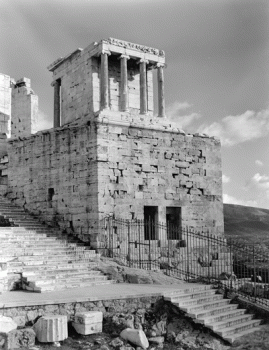American Journal of Archaeology | The Journal of the Archaeological Institute of America
You are here
Knights 843–59, the Nike Temple Bastion, and Cleon’s Shields from Pylos
October 2006 (110.4)
Knights 843–59, the Nike Temple Bastion, and Cleon’s Shields from Pylos
Following his victory over Spartan forces at the battle of Sphakteria in 425 B.C.E. (Thuc. 4.28–40), the demagogue Cleon dedicated several captured Spartan shields in Athens. This same dedication of shields plays a major role in the comic debate for the favor of Demos in Aristophanes’ Knights (lines 843–59), produced a year after Cleon’s triumph. Common opinion holds that the dedication of shields referred to in Knights is the same that Pausanias (1.15.5) saw inside the Stoa Poikile during his tour of the Athenian Agora. There is no reason, however, to believe that Cleon hung all 120 of his Spartiate shields in the Painted Stoa. Indeed, the archaeological context of the famous shield from Pylos excavated in the agora demonstrates that not all of Cleon’s shields were seen by Pausanias in the Stoa Poikile. A set of unusual cuttings on the Nike temple bastion is perhaps relevant here. Since 1908 these cuttings have been interpreted as the fastening points for a dedication of shields. While perfectly suited for this purpose, the form of the cuttings on the Nike bastion is unlike that of cuttings used for dedicated shields known in the archaeological record. Here, it is significant that Aristophanes (Knights 848–49) specifies that Cleon hung his dedicated shields in an unusual manner, namely, with their handles still attached. Considering both the specific language and context of the comedy and how closely Cleon and his victory were associated with the completion of the Temple of Athena Nike, it is possible that strangely hung shields on the Nike temple bastion and Cleon’s strangely hung shields described by Aristophanes are one and the same.
Knights 843–59, the Nike Temple Bastion, and Cleon’s Shields from Pylos
By Mike Lippman, David Scahill, and Peter Schultz
American Journal of Archaeology Vol. 110, No. 4 (October 2006), pp. 551–563
DOI: 10.3764/aja.110.4.551
© 2006 Archaeological Institute of America


